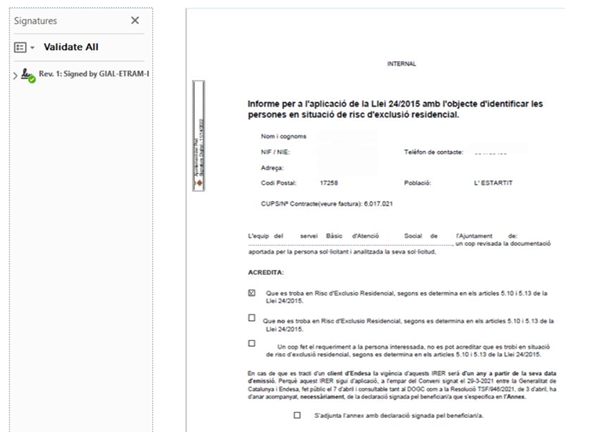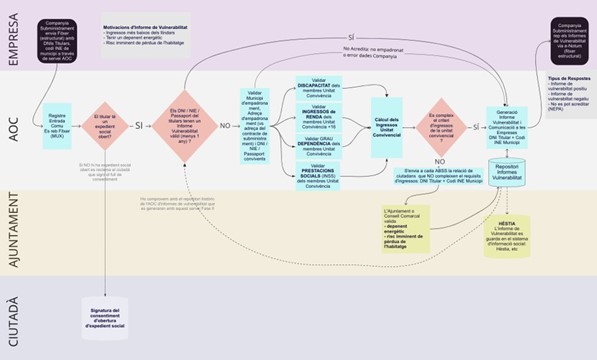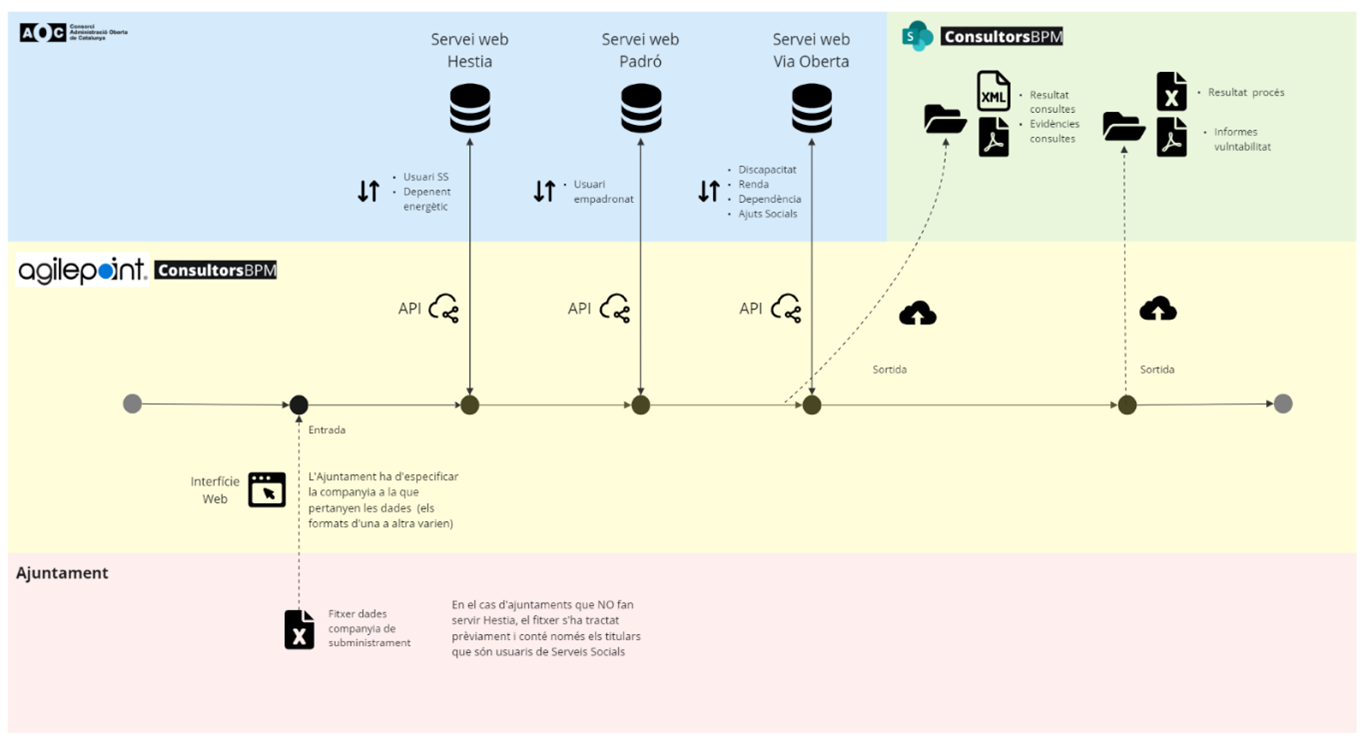Algorithmic transparency: Automation of the energy poverty report

Overview
It is a cloud service that automates the social reporting of energy vulnerability, both the management process and the preparation of the report.
use case
Social reports of energy vulnerability, also known as energy poverty reports, are prepared monthly by the Basic Areas of Social Services (ABSS) in compliance with the Law 24/2015, on urgent measures to deal with the emergency in the field of housing and energy poverty. The aim is to prove the economic vulnerability of people or family units at risk of residential exclusion in the face of possible electricity, gas and potable water supply cuts due to non-payment.
These reports are generated at the request of the supply companies (more than 50 different companies), following the precautionary principle established by law.
Currently, the data verification process is manual and lacks standardization. Faced with this situation and bearing in mind that much of the data required for the preparation of the reports can be consulted through Via Oberta's interoperability services, the AOC has developed a cloud solution to automate this process, improving interoperability between companies, municipalities and other administrations to verify data. The solution is an AI-based complex process automation system, using robotic process automation (RPA) and business process modeling (BPM) technologies. In addition, it is based on a cloud service provided by a private company, does not require installation, but does integrate with many other AOC information systems, such as interoperability services Via Abierta and the social services information system Beast
Status
pilot The service is being tested in 6 municipalities. Pilot municipalities:
- El Prat de Llobregat (65.030 inhab.), Amposta (21.807 inhab.), Granollers (61.983 inhab.), Sant Boi de Llobregat (83.371 inhab.), Palau Solità i Plegamans (14.911 inhab.) and Santa Coloma de Gramenet (117.981 hab.)
The first pilot that was launched was that of Prat de Llobregat, in April 2023.
Main benefits of the service
Benefits for citizens:
- Better service and agility in attention: The automation and standardization of the process allows a faster and more accurate response to cases of energy vulnerability, improving the quality of social services and attention to people at risk.
- Ensure access to basic supplies: Through this system, the determination of the vulnerability situation is expedited, ensuring that people and family units at risk receive the attention and basic supplies they need.
- Reduction of bureaucracy and improvement of the user experience: The automated process avoids unnecessary procedures and simplifies interaction with the Administration, reducing bureaucracy and improving the experience of citizens in vulnerable situations.
Benefits for the administration:
- Saving time and resources: Significant reduction of the time and administrative tasks required to generate the energy poverty reports, allowing better management of the Administration's human and economic resources and optimizing its performance.
- Standardization and improvement in data management: Through the integration of multiple data sources and their automation, a more precise and standardized view of the energy vulnerability situation is achieved, improving decision-making and facilitating communication between companies, municipalities and other administrations.
- Support for municipalities with limited resources: The cloud service offers the possibility of access to advanced technology without the need for large investments in infrastructure or internal resources.
Contact information
Responsible body
Open Administration of Catalonia
Contact team for inquiries
Innovation and Data Branch
Team email
innovacio@aoc.cat
External supplier
BPM Consultants
Supplier email
jordiburgas@consultorsbpm.com
More detailed information about the service
Familiarize yourself with the information the system uses, the algorithm's operating logic, and its governance.
Data sets
Input data
Two main sources of input data are used:
1) Data from the structured .xls files sent by the energy supply companies
- DNI
- INE code of the municipality
- Postal address of the holder
2) Data that feeds the algorithm for calculating the coefficient of the energy poverty report
A. Open Way data
Via Abierta is an interoperability service offered by the AOC to facilitate the electronic exchange of data and documents between administrations and public entities within the framework of an administrative procedure and with the aim of making effective the right of citizens not to contribute documents that are already in the possession of public administrations.
Through the services of Via Oberta, the data necessary to carry out the automated calculation of the coefficient that will determine whether the person or family unit is in a vulnerable situation is consulted.
Specifically, the following data is consulted:
- Register data. This query allows:
- Check that the person holding the supply contract is registered at the address that appears in the file that the energy suppliers send to the different ABSS where the affected contracts are recorded. Method of consultation: Registration data of an owner.
- Obtain the total number of cohabitants over the age of 16 and their data. Query method: Coexistence data of a holder.
Below are 4 Via Oberta services that return economic results that add up to each other.
- Income data. Method of consultation: C4 – Income for social benefits of the AEAT, if the person has submitted the declaration of personal income tax; Imputation certificate, when the taxpayer is not required to present it.
- Public pensions exempt from AEAT. This query returns the number of existing records and the total amount (field: remuneration) which is added to the general amount.
- SEPE unemployment benefits. From this query, the amount obtained per period certificate is obtained (field: gross amount) and added to the general amount.
- Public social benefits of the INSS. Type: current pensions. The number of payments and the monthly gross amount are obtained from this query.
2 Via Oberta services are also consulted that do not return amounts but will affect the reference threshold:
- SISPAP disability. Query mode: Basic data. Information on whether or not recognition of disability exists is extracted from this query.
- Department of the IMSERSO. Consultation method: Level and degree of dependence. From this query it is extracted whether the person has a grade III - level 1 or 2 (high dependency).
All these consultations are repeated for each member of the cohabitation unit over the age of 16. Once these amounts have been added up, the income of the cohabitation unit is obtained. These incomes will have to be compared with the reference tables, taking into consideration what the regulations specify to define if they are in a situation of energy vulnerability.
B. Hestia data or own social information system
Beast is an information system for social services used by more than 800 councils (91 ABSS users according to 2023 data). It allows to have the files of social services of the citizens in electronic format.
The following data can be obtained by consulting the social services file of the holder:
- Energy dependence. (article 5.13 of Law 24/20115)
- Imminent risk of losing the home
Output data
Data and documents generated by the service:
- Vulnerability reports
- Evidence of the process
❗ Considerations about the processing of input data and the preservation of vulnerability reports and evidence:
- The data that is managed during the generation process of the energy poverty report is owned by the councils that participate in the pilot. The pilot councils sign an order for the processing of personal data with the company awarded the service contract for the implementation of the solution (ConsultorsBPM). The AOC does not access any personal data in the process of automating the report.
- The processing of input data involves:
- Processing Manager (pilot municipality)
- Processing Manager (ConsultorsBPM)
- Vulnerability reports are saved in a Microsoft Sharepoint instance of ConsultorsBPM to which authorized persons in the pilot municipalities have access with a username and password.
- Evidence and related files are kept for one month. Positive vulnerability reports are valid for one year and are currently all retained.
Data processing
The operational logic of automatic data processing and the reasoning carried out by the system is based on the following model and methodology:
Step by step of the process
The AI system allows the BPM AgilePoint platform to upload the .xls files that the energy suppliers send to the different ABSS where the affected contracts are recorded. The initial screen includes the functionality to ask for the password of the files since some companies protect them.
Once the file is uploaded, the first step is to perform a series of checks such as whether the company provided is correct, whether or not the file is password protected and provided, etc.
The system then processes the data and starts the process for each of the records. First of all, it checks that the holders are registered in the municipality and verifies if they have a file registered with Hestia, which authorizes the subsequent consultation of the data.
From here, the system calculates in parallel the coefficients of both the holder and the parties, making the corresponding calls to Via Oberta. Once all document query calls are completed, the system calculates the coefficient, automatically generates the vulnerability report model and the signa.
The last step is the communication to the supply companies (this last step is not yet automated, it is being redefined and in the development phase).
- Flow diagram of the process

Service architecture
The solution runs on a cloud platform provided by the private company ComsultorsBPM. The platform is AgilePoint and is where the AI algorithm runs. It is a multi-user, multi-platform and multi-device runtime environment, and allows controlled access to data.
The generated reports are stored in a Microsoft Sharepoint repository hosted on Microsoft Azure servers, within the European Community.
Integrations with Via Oberta are carried out through web services. Consultations at Via Oberta are carried out with the CDA electronic seal (certificate of application device) from the town hall, which gives it to the company ConsultorsBPM.
The company ConsultorsBPM makes calls to Via Oberta from a centralized public IP.
- Technological diagram:

Algorithm performance
A success rate of 90% is currently achieved. With legal and organizational changes, this figure could reach almost 100%.
Human supervision
The algorithm works directly, but requires the supervision of a person who validates the results before sending them to the supply companies. Human supervision is essential to ensure the accuracy and consistency of the reports generated and to avoid possible errors in specific cases that may escape the logic of the system.
Regulatory compliance of the system
The automation service of the energy poverty report (contains the algorithm) meets the requirements of current regulations, especially regarding the protection of personal data in relation to the European and national legal framework. Specifically:
El Responsible for Treatment (pilot municipality), theIn charge of the Treatment (ConsultorsBPM) and all its staff are subject to data protection regulations, in particular Organic Law 3/2018, of December 5, on the protection of personal data and guarantee of digital rights (hereinafter LOPDGDD) and Regulation (EU) 2016/679 of the European Parliament and of the Council, of April 27, 2016, relating to the protection of natural persons and the free movement of such data and which repeals Directive 95/46/CE (General data protection regulation, published in the Official Journal of the European Union -DOUE of 4-05-2016-, hereinafter RGPD).
Regarding the RGPD, we highlight the application of the following principles:
- Data minimization principle: only the necessary data is collected to fulfill the purpose of the service (generate the energy poverty report that is regulated by the Llei 24 / 2015)
- Purpose limitation principle of the RGPD: the data collected is only used for the purpose communicated to the person concerned.
Regarding the consent of the person interested in the issuance of the energy poverty report: In accordance with the Statute of Autonomy and the Catalan Social Services Act 12/2007, which determine that every person has the right to decide whether or not to receive a social benefit, it is necessary for the interested person to give consent for the completion of this report.
The information systems associated with this service also comply with current regulations.
- Regarding interoperability (consultations in Via Oberta):
- Comply with the Law 39/2015, of 1 October, on the common administrative procedure of public administrations (art. 28.2) i Law 26/2010, of August 3, on the regime and procedure of the public administrations of Catalonia (art 25.4)
- The data obtained through Via Oberta has an administrative file at the back and can only be consulted within the framework of the procedures authorized by the transferors of the data.
- According to article 1.1 of the seventh final provision of Law 2/2014 on fiscal, administrative, financial and public sector measures, amended by Law 5/2020 (article 163), consultations on Via Oberta are carried out without the consent of the person concerned or of the people in their cohabitation unit.
Now, although consent is not required, it is it is necessary to inform the interested person so that he can oppose the data consultation by the administration (article 28, law 39/2015). In this case, if the person objects, they should provide the documentation themselves.
This is a Automated Administrative Action (AAA)? Yes
In this, the pilot Council is subject to the legal obligation to publish the AAA linked to the service at the e-headquarters, accompanied by a technical file (See article 11, letter i, of Royal Decree 203/2021, which approves the Regulation of performance and operation of the public sector by electronic means; which deploys Law 40/2015 on the Legal Regime of the Public Sector). The technical sheet will have the following information:
- Name of the AAA and the administrative procedure in which it is located
- Body responsible for the action or procedure: pilot council
- Responsible body for appeal purposes (article 41.2 of Law 40/2015 on the Legal Regime of the Public Sector)
- SInformation system where the procedure takes place
- Classification according to the ENS
- Classification according to the RGPD
- E-signature mechanism: electronic seal of the entity
- Audit
- URL (of the e-mail address) where the integrity of the generated document can be checked
- Description of the design and operation of the AAA
- Account retention and transparency mechanisms
- Data used in its configuration and learning
Risk management
Know the most likely risks in relation to the fundamental principles and rights that need to be protected, and the measures applied in each case to ensure compliance with these rights and mitigate the risks.
A. Equality and non-discrimination
- Identified risks: Biases, discrimination
- Measures applied
- To guarantee the right to non-discrimination:
- The data with which the algorithm has been trained is inclusive and represents the different people and family units that can be found in one of the situations at risk of residential exclusion.
- To ensure digital inclusion, a lot has been invested in user experience so that the process of generating poverty reports is simple and easy to use.
- To guarantee the right to non-discrimination:
B. Data protection and privacy
- Identified risks: Misuse of personal data by third parties, threat to privacy
- Measures applied
- In order to identify the risks of the system from the point of view of data protection and privacy, the pilot municipalities will have to carry out an impact assessment on the processing of personal data, given that data processing that presents the following characteristics:
- automated decisions are made with legal effects or that similarly and significantly affect the natural person;
- it deals with data related to vulnerable people;
- innovative use of technologies is made.
- To guarantee the right to data protection and privacy:
- The supplier signs a Treatment Order
- The location of the data is within the European Union
- The Data Controller (pilot council) guarantees the ARCO rights (Access, Rectification, Cancellation and Opposition) of the data being processed.
- Consent and cookies are managed.
- In order to identify the risks of the system from the point of view of data protection and privacy, the pilot municipalities will have to carry out an impact assessment on the processing of personal data, given that data processing that presents the following characteristics:
C. Safety and robustness
- Identified risks: Unavailability of the service, unauthorized access, data leakage, errors and inconsistencies in the result
- Measures applied
- To identify the risks associated with the availability and security of the system, and to categorize the service according to the criticality of the data we will put in it, a security analysis of the service In this way we can ensure that the requirements established by the National Security Scheme (ENS) for systems of the corresponding level are met.
- To avoid system unavailability:
- Within the contract with the supplier, Service Level Agreements (SLAs) have been established that must be complied with and reviewed periodically.
D. Transparency and explainability
- Identified risks: opacity, mistrust, misinformation
- Measures applied
- Publication of the algorithmic transparency sheet on the AOC's Transparency Portal. The sheet contains clear information about:
- Data used to train the algorithm
- Type of algorithm used
- Problem to which a solution is sought
- How it has been implemented
- Who is it aimed at
- Identity and contact details of the algorithm provider
- Body responsible for the service and contact email address for complaints, inquiries and suggestions
- Publication of the algorithmic transparency sheet on the AOC's Transparency Portal. The sheet contains clear information about:
E. Retention of accounts and auditability
- Identified risks: legal uncertainty, lack of system quality
- Measures applied (in definition phase)
More information
- Post "Pilot for the automation of the energy poverty report to avoid supply cuts” (27/1/2023, AOC blog)
- Article "Automating the energy poverty report in Catalonia” (10/10/2023, Joinup Platform of the European Commission)
- Presentation "Automated assessment of energy poverty” (18/10/2023, Semic 2023: Interoperable AI in the Age of AI)
Useful links:
- Call against poverty: the aid model must be reformed. Sonia Fuertes, Marc Simon Martinez, Rosa Balaguer Bueno, Ángels Cadena Bordoll (16/10/2023)
- The impact of administrative procedures on access to social benefits (pdf). Elena Costas Pérez, Juli Ponce Solé, Cristina Ferrer Romero, Miguel Angel Manzano Rodríguez (May 2022)
- Energy poverty in data. Xarxanet.org (18/10/2017)
